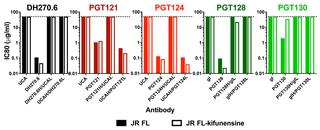当前位置:
X-MOL 学术
›
PLOS Pathog.
›
论文详情
Our official English website, www.x-mol.net, welcomes your
feedback! (Note: you will need to create a separate account there.)
Cooperation between somatic mutation and germline-encoded residues enables antibody recognition of HIV-1 envelope glycans.
PLoS Pathogens ( IF 5.5 ) Pub Date : 2019-12-16 , DOI: 10.1371/journal.ppat.1008165 Nelson R Wu 1, 2 , Nathan I Nicely 1, 2 , Esther M Lee 1, 2 , Rachel K Reed 1, 2 , Brian E Watts 1, 2 , Fangping Cai 1, 2 , William E Walkowicz 3 , Baptiste Aussedat 3 , Julia A Jones 1, 2 , Amanda Eaton 2, 4 , Ashley M Trama 1, 2 , S Munir Alam 1, 2, 5 , David C Montefiori 2, 4 , Barton F Haynes 1, 2, 6 , Kevin O Saunders 2, 4, 6, 7
PLoS Pathogens ( IF 5.5 ) Pub Date : 2019-12-16 , DOI: 10.1371/journal.ppat.1008165 Nelson R Wu 1, 2 , Nathan I Nicely 1, 2 , Esther M Lee 1, 2 , Rachel K Reed 1, 2 , Brian E Watts 1, 2 , Fangping Cai 1, 2 , William E Walkowicz 3 , Baptiste Aussedat 3 , Julia A Jones 1, 2 , Amanda Eaton 2, 4 , Ashley M Trama 1, 2 , S Munir Alam 1, 2, 5 , David C Montefiori 2, 4 , Barton F Haynes 1, 2, 6 , Kevin O Saunders 2, 4, 6, 7
Affiliation

|
Viral glycoproteins are a primary target for host antibody responses. However, glycans on viral glycoproteins can hinder antibody recognition since they are self glycans derived from the host biosynthesis pathway. During natural HIV-1 infection, neutralizing antibodies are made against glycans on HIV-1 envelope glycoprotein (Env). However, such antibodies are rarely elicited with vaccination. Previously, the vaccine-induced, macaque antibody DH501 was isolated and shown to bind to high mannose glycans on HIV-1 Env. Understanding how DH501 underwent affinity maturation to recognize glycans could inform vaccine induction of HIV-1 glycan antibodies. Here, we show that DH501 Env glycan reactivity is mediated by both germline-encoded residues that contact glycans, and somatic mutations that increase antibody paratope flexibility. Only somatic mutations in the heavy chain were required for glycan reactivity. The paratope conformation was fragile as single mutations within the immunoglobulin fold or complementarity determining regions were sufficient for eliminating antibody function. Taken together, the initial germline VHDJH rearrangement generated contact residues capable of binding glycans, and somatic mutations were required to form a flexible paratope with a cavity conducive to HIV-1 envelope glycan binding. The requirement for the presence of most somatic mutations across the heavy chain variable region provides one explanation for the difficulty in inducing anti-Env glycan antibodies with HIV-1 Env vaccination.
中文翻译:

体细胞突变和种系编码的残基之间的合作使抗体识别HIV-1包膜聚糖成为可能。
病毒糖蛋白是宿主抗体应答的主要靶标。但是,病毒糖蛋白上的聚糖可能会阻碍抗体识别,因为它们是衍生自宿主生物合成途径的自身聚糖。在天然HIV-1感染期间,会针对HIV-1包膜糖蛋白(Env)上的聚糖制备中和抗体。然而,很少通过疫苗接种引起此类抗体。以前,已分离出疫苗诱导的猕猴抗体DH501,并显示与HIV-1 Env上的高甘露糖聚糖结合。了解DH501如何进行亲和力成熟以识别聚糖,可以为HIV-1聚糖抗体的疫苗诱导提供信息。在这里,我们显示DH501 Env聚糖反应性是由接触聚糖的种系编码残基和增加抗体对位柔性的体细胞突变介导的。聚糖反应性仅需要重链中的体细胞突变。对位构象很脆弱,因为免疫球蛋白折叠或互补决定区内的单个突变足以消除抗体功能。综上所述,初始种系VHDJH重排产生了能够结合聚糖的接触残基,并且需要体细胞突变以形成具有有助于HIV-1包膜聚糖结合的腔的柔性互补位。重链可变区中存在大多数体细胞突变的要求为用HIV-1 Env疫苗诱导诱导抗Env聚糖抗体的困难提供了一种解释。对位构象很脆弱,因为免疫球蛋白折叠或互补决定区内的单个突变足以消除抗体功能。综上所述,初始种系VHDJH重排产生了能够结合聚糖的接触残基,并且需要体细胞突变以形成具有有助于HIV-1包膜聚糖结合的腔的柔性互补位。重链可变区中存在大多数体细胞突变的要求为用HIV-1 Env疫苗诱导诱导抗Env聚糖抗体的困难提供了一种解释。对位构象很脆弱,因为免疫球蛋白折叠或互补决定区内的单个突变足以消除抗体功能。综上所述,初始种系VHDJH重排产生了能够结合聚糖的接触残基,并且需要体细胞突变以形成具有有助于HIV-1包膜聚糖结合的腔的柔性互补位。重链可变区中存在大多数体细胞突变的要求为用HIV-1 Env疫苗诱导诱导抗Env聚糖抗体的困难提供了一种解释。需要进行体细胞突变并形成柔性互补位,该柔性互补位具有有助于HIV-1包膜聚糖结合的空腔。重链可变区中存在大多数体细胞突变的要求为用HIV-1 Env疫苗诱导诱导抗Env聚糖抗体的困难提供了一种解释。需要进行体细胞突变和体突变以形成具有有助于HIV-1包膜聚糖结合的腔的柔性互补位。重链可变区中存在大多数体细胞突变的要求为用HIV-1 Env疫苗诱导诱导抗Env聚糖抗体的困难提供了一种解释。
更新日期:2019-12-17
中文翻译:

体细胞突变和种系编码的残基之间的合作使抗体识别HIV-1包膜聚糖成为可能。
病毒糖蛋白是宿主抗体应答的主要靶标。但是,病毒糖蛋白上的聚糖可能会阻碍抗体识别,因为它们是衍生自宿主生物合成途径的自身聚糖。在天然HIV-1感染期间,会针对HIV-1包膜糖蛋白(Env)上的聚糖制备中和抗体。然而,很少通过疫苗接种引起此类抗体。以前,已分离出疫苗诱导的猕猴抗体DH501,并显示与HIV-1 Env上的高甘露糖聚糖结合。了解DH501如何进行亲和力成熟以识别聚糖,可以为HIV-1聚糖抗体的疫苗诱导提供信息。在这里,我们显示DH501 Env聚糖反应性是由接触聚糖的种系编码残基和增加抗体对位柔性的体细胞突变介导的。聚糖反应性仅需要重链中的体细胞突变。对位构象很脆弱,因为免疫球蛋白折叠或互补决定区内的单个突变足以消除抗体功能。综上所述,初始种系VHDJH重排产生了能够结合聚糖的接触残基,并且需要体细胞突变以形成具有有助于HIV-1包膜聚糖结合的腔的柔性互补位。重链可变区中存在大多数体细胞突变的要求为用HIV-1 Env疫苗诱导诱导抗Env聚糖抗体的困难提供了一种解释。对位构象很脆弱,因为免疫球蛋白折叠或互补决定区内的单个突变足以消除抗体功能。综上所述,初始种系VHDJH重排产生了能够结合聚糖的接触残基,并且需要体细胞突变以形成具有有助于HIV-1包膜聚糖结合的腔的柔性互补位。重链可变区中存在大多数体细胞突变的要求为用HIV-1 Env疫苗诱导诱导抗Env聚糖抗体的困难提供了一种解释。对位构象很脆弱,因为免疫球蛋白折叠或互补决定区内的单个突变足以消除抗体功能。综上所述,初始种系VHDJH重排产生了能够结合聚糖的接触残基,并且需要体细胞突变以形成具有有助于HIV-1包膜聚糖结合的腔的柔性互补位。重链可变区中存在大多数体细胞突变的要求为用HIV-1 Env疫苗诱导诱导抗Env聚糖抗体的困难提供了一种解释。需要进行体细胞突变并形成柔性互补位,该柔性互补位具有有助于HIV-1包膜聚糖结合的空腔。重链可变区中存在大多数体细胞突变的要求为用HIV-1 Env疫苗诱导诱导抗Env聚糖抗体的困难提供了一种解释。需要进行体细胞突变和体突变以形成具有有助于HIV-1包膜聚糖结合的腔的柔性互补位。重链可变区中存在大多数体细胞突变的要求为用HIV-1 Env疫苗诱导诱导抗Env聚糖抗体的困难提供了一种解释。











































 京公网安备 11010802027423号
京公网安备 11010802027423号